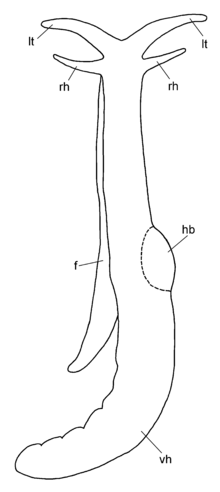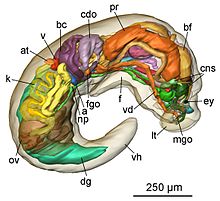- Acochlidiacea
-
Acochlidiacea
Temporal range: Recent
Acochlidium fijiiensis Scientific classification Kingdom: Animalia Phylum: Mollusca Class: Gastropoda (unranked): clade Heterobranchia
clade Euthyneura
clade Panpulmonata
clade Acochlidiacea
Odhner, 1937[1]Families (unranked) Hedylopsacea
- Acochlidiidae: Acochlidium, Palliohedyle, Strubellia
- Pseudunelidae: Pseudunela
- Aitengidae: Aiteng
- Hedylopsidae: Hedylopsis
- Tantulidae: with the only species Tantulum elegans
(unranked) Microhedylacea
- Asperspinidae: Asperspina – junior synonym: Minicheviellidae
- Microhedylidae s.l.: Pontohedyle, Parhedyle, Microhedyle – including Ganitidae: Ganitus and Paraganitus
Diversity * 30 species (including one described and one undescribed species of Aitengidae) in 2010[2] - 32 species in 2011[3]
Synonyms[4][5] Acochlidiomorpha
Acochlidiida
Acochlidea
AcochlidiaAcochlidiacea, common name acochlidians, are a taxonomic clade of very unusual sea snails and sea and freshwater slugs, aquatic gastropod mollusks within the large clade Heterobranchia. Acochlidia is a variant spelling.
 Schematic drawing of dorsal view of Pseudunela cornuta shows some characteristics of acochlidians, but characteristics of other acochlidians differ greatly:
Schematic drawing of dorsal view of Pseudunela cornuta shows some characteristics of acochlidians, but characteristics of other acochlidians differ greatly:
f – foot
hb – heart bulb
lt – labial tentacle
rh – rhinophore
vh – visceral hump.Contents
Description
These are mostly very small animals, without a shell or gills, distinguished by the visceral mass being sharply set off from the rest of the body.[6]
Being a small group with only 30 species worldwide known in 2010,[7] and 32 species described in 2011,[3] these slugs are morphologically and biologically highly aberrant and diverse, comprising a series of unusual characters (e.g. secondary gonochorism, lack of copulatory organs, asymmetric radulae).[2] Most acochlidians live interstitially in marine sands, while some have conquered limnic systems (uniquely within opisthobranch gastropods).[2]
Taxonomy
Nils Hjalmar Odhner established this taxon as a family in 1937, when he created the families Microhedylidae and Acochlidiidae.[1][4] In 1939, he treated this taxon as an order.[4][8]
Rankin (1979)[9] treated this taxon as an order, the order Acochlidioidea.[4][5]
Salvini-Plawen (1983)[10] wrote this taxon as Acochlidiomorpha.[5]
Anderson (1992)[11] treated this taxon as the order Acochlidiida.[4][5]
Burn in Beesley et al (1998), wrote this taxon as the order Acochlidea.[5]
Wawra (1987)[12] and various authors (2007–2010)[2][13][14][15] spelled this taxon as Acochlidia.
Three families (Hedylopsidae, Microhedylidae and Acochlidiidae) are classically recognized.[4][5] Two controversial classifications (Rankin 1979,[9] Starobogatov 1983)[16] have been proposed recently, but they have not been evaluated since.[4][5]
An alternative classification by Burn (in Beesley et al., 1998) for the Australian species recognizes 2 superfamilies and 5 families.[4][5]
The Acochlidia, a traditional "order" of the Opisthobranchia since their establishment by Odhner have formed one of the unsolved mysteries within Euthyneura.[2] Their monophyly is widely accepted especially since a proposed sister group relationship of the acochlidian family Ganitidae with Sacoglossa (based on the dagger-shaped radula teeth) could be rejected based on a comprehensive parsimony analysis of morphological characters.[2] During the last years a series of studies have redescribed key acochlidian taxa in great detail, including 3D reconstructions, and added considerably to the morphological and biological knowledge of this previously little understood group.[2]
Most recent morphological analyses suggested a common origin with either the equally enigmatic Rhodopemorpha, the diaphanid cephalaspidean Toledonia, or with runcinid or philinoid cephalaspideans.[2] Molecular markers independent from direct ecological pressures suggested an unresolved basal opisthobranch origin for Acochlidia (based on nuclear 18S rRNA and 28S rRNA) (Vonnemann et al. 2005).[2][17] A first combined multi-gene dataset led to the surprising result of Acochlidia clustering in a pulmonate relationship, united in a clade with Pyramidelloidea, Amphiboloidea and Eupulmonata.[2] However, only three derived acochlids were included into analysis prior to 2010, with partially missing data.[2]
2005 taxonomy
The taxonomy of Bouchet & Rocroi (2005)[4] tentatively follows Starobogatov (1983),[16] but they have downgraded his taxonomic ranks (suborders to superfamilies, superfamilies to families).[4][5] The group Acochlidiacea is arranged as follows:
- Superfamily Acochlidioidea
- Family Acochlidiidae
- Superfamily Hedylopsoidea
- Family Hedylopsidae
- Family Ganitidae
- Family Livorniellidae
- Family Minicheviellidae
- Family Parhedylidae
- Family Tantulidae
- Superfamily Palliohedyloidea
- Family Palliohedylidae
- Superfamily Strubellioidea
- Family Strubelliidae
- Family Pseudunelidae
2010 taxonomy
A first comprehensive cladistic analysis of their phylogeny has been established by Schrödl & Neusser (2010),[15] but the identity of their sister group remained uncertain. Morphology-based analyses by Schrödl & Neusser,[15] demonstrated that Acochlidia usually group with other mesopsammic (they live in interstitial spaces of marine sands) taxa, if any were included (i.e. with the sacoglossan Platyhedyle, the rhodopemorph Rhodope or the cephalaspideans Philinoglossa or Philine exigua).[2] Thus, it is likely that convergent adaptations to the interstitial habitat mask the truly phylogenetic signals.[2]
Schrödl & Neusser (2010)[15] have splitted Acochlidiacea into two (unranked) taxa and into six families like this:
Hedylopsacea
(unranked) Hedylopsacea has no superfamilies defined:[15]
- Acochlidiidae: Acochlidium, Palliohedyle, including Strubellia
- Pseudunelidae: with the only genus Pseudunela
- Hedylopsidae: with the only genus Hedylopsis
- Tantulidae: with the only species Tantulum elegans
Microhedylacea
(unranked) Microhedylacea has no superfamilies defined:[15]
- Asperspinidae: with the only genus Asperspina – junior synonym: Minicheviellidae
- Microhedylidae s.l.: Pontohedyle, Parhedyle, Microhedyle – including Ganitidae: Ganitus and Paraganitus. Inclusion of Ganitidae within Microhedylidae requires further research and higher statistical support.[15]
A multi-locus molecular study by Jörger et al. (2010),[2] included six out of seven acochlidian families.[2] It confirmed Acochlidiacea in a pulmonate relationship, as sister to Eupulmonata.[2] Euthyneura, Opisthobranchia and Pulmonata as traditionally defined were found non-monophyletic.[2] The enigmatic amphibious and insectivorous Aitengidae clusters within Acochlidiacea, as sister to meiofaunal and brackish Pseudunelidae and limnic Acochlidiidae.[2] Inclusion of this small acochlidian group resulted in redefinition of major groups within Heterobranchia, that has led to creation new clades Euopisthobranchia and Panpulmonata.[2]
Phylogeny
There is no fossil record of Acochlidiacea. Application of molecular clock allowed to estimate divergence times for these groups. The split between Eupulmonata and Acochlidiacea took place in the Mesozoic, between the Triassic and Jurassic periods. The diversification of Acochlidia is estimated to have happened in the Jurassic with the split between Hedylopsacea and Microhedylacea.[2]
Overview of species
- Hedylopsis spiculifera (Kowalevsky, 1901) (Hedylopsidae)
- Hedylopsis ballantinei Sommerfeldt & Schrödl, 2005 (Hedylopsidae)
- Pseudunela cornuta (Challis, 1970) (Pseudunelidae) – marine and temporary brackish[3]
- Pseudunela eirene Wawra, 1988 (Pseudunelidae) – marine
- Pseudunela espiritusanta Neusser & Schrödl, 2009 (Pseudunelidae) – in brackish water
- Pseudunela marteli Neusser, Jörger & Schrödl, 2011 (Pseudunelidae) – marine[3]
- Pseudunela viatoris Neusser, Jörger & Schrödl, 2011 (Pseudunelidae) – marine[3]
- Aiteng ater Swennen & Buatip, 2009 (Aitengidae) – marine (and brackish)
- undescribed species Aiteng mysticus from Japan (Aitengidae)[3][18]
- Strubellia paradoxa (Strubell, 1892) (Acochlidiidae) – freshwater
- Acochlidium amboinense (Strubell, 1892) (Acochlidiidae) – freshwater
- Acochlidium bayerfehlmanni Wawra, 1980 (Acochlidiidae) – freshwater
- Acochlidium fijiiensis Haynes & Kenchington, 1991[19] (Acochlidiidae) – freshwater
- Palliohedyle sutteri (Wawra, 1979) (Acochlidiidae) – freshwater
- Palliohedyle weberi (Bergh, 1895) (Acochlidiidae) – in brackish waters
- Tantulum elegans Rankin, 1979 (Tantulidae) – freshwater
- Asperspina brambelli (Swedmark, 1968) (Asperspinidae)
- Asperspina murmanica (Kudinskaya & Minichev, 1978) (Asperspinidae)
- Asperspina rhopalotecta Salvini-Plawen, 1973 (Asperspinidae)
- Asperspina loricata (Swedmark, 1968) (Asperspinidae)
- Asperspina riseri (Morse, 1976) (Asperspinidae)
- Microhedyle glandulifera (Kowalevsky, 1901) (Microhedylidae)
- Microhedyle nahantensis (Doe, 1974) (Microhedylidae)
- Microhedyle odhneri (Ev. Marcus & Er. Marcus, 1955) (Microhedylidae)
- Microhedyle remanei (Er. Marcus, 1953) (Microhedylidae)
- Ganitus evelinae Marcus, 1953 (Microhedylidae s.l. / Ganitidae)
- Paraganitus ellynnae Challis, 1968 (Microhedylidae s.l. / Ganitidae)
- Parhedyle cryptophthalma (Westheide & Wawra, 1974) (Microhedylidae)
- Parhedyle tyrtowii (Kowalevsky, 1900) (Microhedylidae)
- Parhedyle gerlachi (Ev. Marcus & Er. Marcus, 1959) (Microhedylidae)
- Pontohedyle milaschewitchii (Kowalevsky, 1901) (Microhedylidae)
- Pontohedyle verrucosa (Challis, 1970) (Microhedylidae)
References
This article incorporates CC-BY-2.0 text from the reference [2] and CC-BY-SA-3.0 text from the reference.[5]
- ^ a b (German) Odhner N. H. (1937). "Hedylopsis suecica n.sp. und die Nacktschneckengruppe Acochlidiacea (Hedylacea)". Zoologischer Anzeiger 120(3–4): 51–64. 52, 62.
- ^ a b c d e f g h i j k l m n o p q r s t u Jörger K. M., Stöger I., Kano Y., Fukuda H., Knebelsberger T. & Schrödl M. (2010). "On the origin of Acochlidia and other enigmatic euthyneuran gastropods, with implications for the systematics of Heterobranchia". BMC Evolutionary Biology 10: 323. doi:10.1186/1471-2148-10-323.
- ^ a b c d e f Neusser T. P., Jörger K. M. & Schrödl M. (2011). "Cryptic Species in Tropic Sands - Interactive 3D Anatomy, Molecular Phylogeny and Evolution of Meiofaunal Pseudunelidae (Gastropoda, Acochlidia)". PLoS ONE 6(8): e23313. doi:10.1371/journal.pone.0023313.
- ^ a b c d e f g h i j Bouchet P., Rocroi J.-P., Frýda J., Hausdorf B., Ponder W., Valdés Á. & Warén A. (2005). "Classification and nomenclator of gastropod families". Malacologia: International Journal of Malacology (Hackenheim, Germany: ConchBooks) 47 (1-2): 1–397. ISBN 3925919724. ISSN 0076-2997. http://www.archive.org/details/malacologia47122005inst.
- ^ a b c d e f g h i j Gofas, S. (2010). Acochlidiacea. In: Bouchet, P.; Gofas, S.; Rosenberg, G. (2010) World Marine Mollusca database. Accessed through: World Register of Marine Species at http://www.marinespecies.org/aphia.php?p=taxdetails&id=411937 on 2010-11-30
- ^ Barnes, Robert D. (1982). Invertebrate Zoology. Philadelphia, PA: Holt-Saunders International. p. 376. ISBN 0-03-056747-5.
- ^ There are 29 valid species plus one undescribed species
- ^ Odhner N. H. (1939). "Opisthobranchiate Mollusca from the western and northern coasts of Norway". Det Kongelige Norske Videnskabers Selskabs Skrifter 1939(1): 1–92. page 5.
- ^ a b Rankin J. J. (1979). "A freshwater shell-less mollusc from the Caribbean: structure, biotics, and contribution to a new understanding of the Acochlidioidea". Royal Ontario Museum, Life Sciences Contributions 116: 123 pp., page 83.
- ^ Salvini-Plawen L. v. (1983). Mollusca. In: Fauna & Flora des Mittelmeeres. Riedl R. (ed.) P. Parey. Hamburg & Berlin, 248–390. page 309.
- ^ Anderson C. (1992). Classification of organisms living and fossil. Golden Crown Press, Lancaster, Ohio, 69 pp., page 37.
- ^ Wawra E. (1987). "Zur Anatomie einiger Acochlidia (Gastropoda, Opisthobranchia) mit einer vorläufigen Revision des Systems und einem Anhang über Platyhedylidae (Opisthobranchia, Ascoglossa)". PhD thesis. Universität Wien.
- ^ Neusser T. P., Jörger K. M. & Schrödl M. (2007). "Exploring cerebral features in Acochlidia (Gastropoda: Opisthobranchia)". Bonn. Zool. Beitr. 55: 301–310.
- ^ Jörger K. M., Heβ M., Neusser T. P. & Schrödl M. (2009). "Sex in the beach: spermatophores, dermal insemination and 3D sperm ultrastructure of the aphallic mesopsammic Pontohedyle milaschewitchii (Acochlidia, Opisthobranchia, Gastropoda)". Marine Biology 156: 1159–1170. doi:10.1007/s00227-009-1158-5.
- ^ a b c d e f g Schrödl M. & Neusser T. P. (2010). "Towards a phylogeny and evolution of Acochlidia (Mollusca: Gastropoda: Opisthobranchia)". Zoological Journal of the Linnean Society 158: 124–154. doi:10.1111/j.1096-3642.2009.00544.x.
- ^ a b (Russian) Starobogatov Ya. I. (1983). "Sistema otriada Acochlidiiformes [System of the order Acochlidiiformes]." Vsesoiuznoe soveshchanie po izucheniiu molliuskov, Leningrad, 7: 30–32.
- ^ Vonnemann V., Schrödl M., Klussmann-Kolb A. & Wägele H. (2005). "Reconstruction of the phylogeny of the Opisthobranchia (Mollusca: Gastropoda) by means of 18s and 28s rRNA gene sequences". Journal of Molluscan Studies 71 (2): 113–125. doi:10.1093/mollus/eyi014.
- ^ Neusser T. P., Fukuda H., Jörger K. M., Kano Y. & Schrödl M. (in press) "Sacoglossa or Acochlidia? 3D-reconstruction, molecular phylogeny and evolution of Aiteng ater and Aiteng mysticus n. sp. (Aitengidae, Gastropoda)". Journal of Molluscan Studies.
- ^ Haynes A. & Kenchington W. (1991). "Acochlidium fijiiensis sp. nov. (Gastropoda: Opisthobranchia: Acochlidiacea) from Fiji". The Veliger 34(2): 166–171.
External links
Categories:- Panpulmonata
Wikimedia Foundation. 2010.

